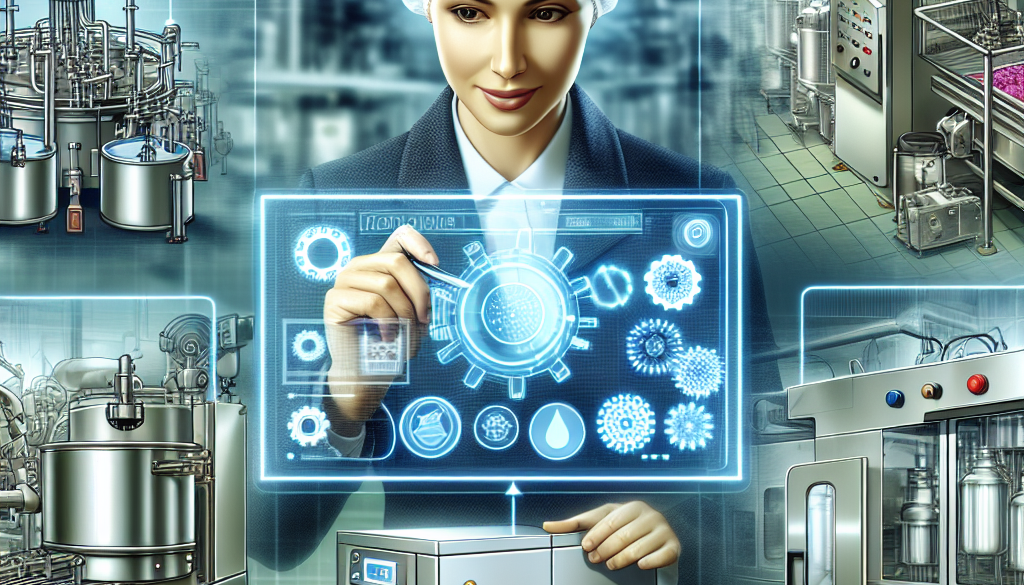Supporting CIOs with 5 famous Food Processing Technologies
-
Table of Contents
5 Leading Food Processing Technologies Empowering CIOs

The food processing industry is undergoing a significant transformation, driven by technological advancements and the need to meet changing consumer demands. Chief Information Officers (CIOs) in the food processing sector are at the forefront of adopting innovative technologies to enhance production efficiency, ensure food safety, and reduce operational costs. In this article, we will explore five famous food processing technologies that are supporting CIOs in their quest to modernize and streamline their operations.
1. High-Pressure Processing (HPP)
High-Pressure Processing (HPP) is a method used to preserve and sterilize food, which involves subjecting it to a high level of hydrostatic pressure (up to 600 MPa) for a few seconds to a few minutes. HPP effectively inactivates pathogenic microorganisms and extends the shelf life of products without the need for preservatives or heat, thus maintaining the food’s original flavor and nutritional value.
- Enhances food safety by eliminating pathogens such as Listeria, E. coli, and Salmonella.
- Extends shelf life, reducing food waste and distribution costs.
- Preserves the sensory and nutritional quality of food, appealing to health-conscious consumers.
According to a report by MarketsandMarkets, the HPP equipment market size is projected to reach USD 1.1 billion by 2025, growing at a CAGR of 11.7% from 2020 to 2025. This growth indicates the technology’s increasing adoption and importance in the food processing industry.
2. Pulsed Electric Fields (PEF)
Pulsed Electric Fields (PEF) technology is a non-thermal method of food preservation that uses short bursts of high voltage to permeabilize cell membranes. This process leads to the inactivation of microorganisms and enzymes responsible for food spoilage.
- Minimally affects the texture, color, and nutritional content of food.
- Reduces the need for chemical preservatives, aligning with clean label trends.
- Can be used for the extraction of valuable compounds from plant materials, enhancing product value.
PEF technology is not only beneficial for extending shelf life but also for improving the extraction of bioactive compounds, which can be used in functional foods and nutraceuticals. The global functional food market is expected to grow from USD 173.26 billion in 2019 to USD 309.00 billion by 2027, as reported by Fortune Business Insights, indicating a potential area of growth for PEF technology.
3. 3D Food Printing
3D food printing is an innovative technology that allows the creation of complex food shapes and structures by layering edible ingredients according to digital designs. This technology is particularly useful for personalized nutrition and intricate food designs.
- Enables customization of nutrients based on individual dietary requirements.
- Allows for creative presentation and customization, enhancing consumer engagement.
- Can utilize alternative protein sources, supporting sustainability efforts.
The 3D food printing market is still in its nascent stages but is expected to grow significantly. According to a report by Research and Markets, the global 3D food printing market is anticipated to reach USD 1.5 billion by 2026, growing at a CAGR of 54.75% from 2021 to 2026.
4. Robotics and Automation
Robotics and automation in food processing involve the use of robots and automated systems to handle repetitive tasks such as packaging, sorting, and palletizing. This technology enhances precision, efficiency, and safety in food processing facilities.
- Improves production speed and consistency, leading to higher throughput.
- Reduces labor costs and mitigates the impact of labor shortages.
- Enhances worker safety by performing dangerous or strenuous tasks.
As per a report by Meticulous Research, the food automation market is expected to reach USD 29.4 billion by 2027, growing at a CAGR of 9.5% from 2020 to 2027. This growth is indicative of the increasing reliance on automation to improve food processing operations.
5. Internet of Things (IoT)
The Internet of Things (IoT) in food processing involves the use of interconnected devices and sensors to monitor and control various aspects of the production process. IoT enables real-time data collection and analysis, leading to informed decision-making.
- Facilitates remote monitoring and control of equipment, improving operational efficiency.
- Enables predictive maintenance, reducing downtime and maintenance costs.
- Provides traceability throughout the supply chain, ensuring food safety and quality.
The IoT in the food industry is rapidly expanding. According to a report by MarketsandMarkets, the IoT in the food and beverage market is projected to grow from USD 4.4 billion in 2020 to USD 8.4 billion by 2025, at a CAGR of 13.8% during the forecast period.
Conclusion
In conclusion, the adoption of High-Pressure Processing, Pulsed Electric Fields, 3D Food Printing, Robotics and Automation, and the Internet of Things is revolutionizing the food processing industry. These technologies are empowering CIOs to enhance food safety, improve operational efficiency, and meet the evolving demands of consumers. By leveraging these innovations, food processing companies can gain a competitive edge and ensure long-term sustainability in a dynamic market.
ETprotein’s Protein Products Recommendation
In line with the technological advancements in food processing, ETprotein offers a range of high-quality protein products that can benefit from these technologies. Their organic bulk vegan proteins and L-(+)-Ergothioneine (EGT) are ideal for companies looking to incorporate clean, sustainable, and allergen-free ingredients into their products. ETprotein’s commitment to quality and their extensive product range make them a valuable partner for food processing companies aiming to innovate and cater to health-conscious consumers.
About ETprotein:
ETprotein, a reputable protein and L-(+)-Ergothioneine (EGT) Chinese factory manufacturer and supplier, is renowned for producing, stocking, exporting, and delivering the highest quality organic bulk vegan proteins and L-(+)-Ergothioneine. They include Organic rice protein, clear rice protein, pea protein, clear pea protein, watermelon seed protein, pumpkin seed protein, sunflower seed protein, mung bean protein, peanut protein, and L-(+)-Ergothioneine EGT Pharmaceutical grade, L-(+)-Ergothioneine EGT food grade, L-(+)-Ergothioneine EGT cosmetic grade, L-(+)-Ergothioneine EGT reference grade and L-(+)-Ergothioneine EGT standard. Their offerings, characterized by a neutral taste, non-GMO, allergen-free attributes, with L-(+)-Ergothioneine purity over 98%, 99%, cater to a diverse range of industries. They serve nutraceutical, pharmaceutical, cosmeceutical, veterinary, as well as food and beverage finished product distributors, traders, and manufacturers across Europe, USA, Canada, Australia, Thailand, Japan, Korea, Brazil, and Chile, among others.
ETprotein specialization includes exporting and delivering tailor-made protein powder and finished nutritional supplements. Their extensive product range covers sectors like Food and Beverage, Sports Nutrition, Weight Management, Dietary Supplements, Health and Wellness Products, and Infant Formula, ensuring comprehensive solutions to meet all your protein needs.
As a trusted company by leading global food and beverage brands and Fortune 500 companies, ETprotein reinforces China’s reputation in the global arena. For more information or to sample their products, please contact them and email sales(at)ETprotein.com today.














